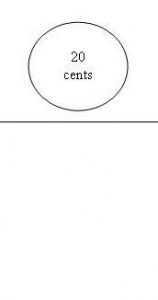Money Lesson 1 for Preschooler
MoneyTalk for Kids November 30th, 2009
My boys were introduced to money when they were really young. Keatkeat helped out in my stall a number of times when he was just 3 years old. The coin he loved most was $1.00. I was clearing my stuff at a ridiculous price of $1 then. So this coin was the denomination he saw most frequently.
Remember my post on training them to keep recordof their ‘income‘ and ‘expenses‘? Its been a year now and Yes, they are still doing it. Its never too young to learn such basic money management.
To prepare him for school next year. We created a series of money lessons for him. Here’s what I did for Lesson 1:
This will work ONLY if your child knows simple addition. And for my mathematician Keatkeat. Teaching him money calculation was a breeze.
Keatkeat was introduced to different denominations many years ago. Started with the smallest denomination > 5 cents (since 1cent is no longer in use).
Since this is just for illustration purposes, I am using 10 cents as the smallest denomination. You can choose to start with 1 cents or 5 cents.
Step 1: Prepare at least 10 pieces of 10 cent coins, 5 pieces of 20 cent coins, 2 pieces of 50 cent coins and 1 piece of 1 dollar coin for this 1st lesson.
Step 2: Place ONE 20 cent coin on a paper with a line drawn at the bottom.

Step 3: I asked, “How many 10 cent coins make 20 cents? Put the 10 cent coins ‘below’ that 20 cent coin.” (below the line)
Step 4: Keatkeat took 2pieces of 10 cent coins and put ‘below‘ the 20 cent coin as shown below:

Step 5: “Very Good!” (Praise Your Child! Never forget *wink*)
Step 6: I Removed the 10 cent coins.
Step 7: I placed another 20 cent coin ON TOP of the 20 cent coin on the table.
Step 8: “How much does 2 20 cent coins make?”
Step 9: “40 cents.”
Step 10: “How many 10 cent coins would make 40 cents? Put the number of 10 cent coins ‘below’ the 40 cents.”
Repeating Step 5-10 by adding ONE 20 cent each time until it reaches $1.00, i.e. 5 pieces of 20 cents.
Step 11: I asked Keatkeat to pick out the $1.00 coin from the bowl which contained many coins (I had prepared $10 worth of assorted coins).
Step 12: I told him to place the $1.00 coin next to the 20 cent coins as such:
Next, add in the 50 cents.
Step 13: “How many 50 cent coins would make 1.00 dollar? Put the number of 50 cent coins between the 20cents and the $1.” (I shifted the $1.00 further away from the 20cents)
Linking everything:
Me: “10 10cents is EQUAL to?” (moving my finger from the 10cent coins to the 20cents)
Keatkeat: “5 20cents”
Me: “Which is also equal to?” (moving my finger from the 20cent coins to the 50cent coins)
Keatkeat: “2 50cents.”
Me: “Which is also equal to?” (moving my finger from the 50cent coins to the 1 dollar coin)
Keatkeat: “1 Dollar.”
After which I asked Keatkeat to say the equation on his own with me saying “which is equal to?” and the moving of my index finger from one group of coins to another.
Lesson 1 is considered to have completed when I could shut my mouth and ‘keep‘ my finger to myself, while Keatkeat recite the whole equation on his own.
Lesson 2 continues in the next post…





December 1st, 2009 at 7:30 am
with such prep class from mommy, keat sure breeze through pri school!! u r really innovative!
December 1st, 2009 at 2:58 pm
great teaching! thanks for sharing :)
December 1st, 2009 at 4:05 pm
Wow…this is very good! At least it make senses. I can try this on my son in future (once he knows his additions). Now, he only knows how to put the coins into the coin box (do not know the value yet). hehe
.-= mnhl´s last blog ..1 year older on 30 NOV =-.
December 1st, 2009 at 11:08 pm
Great lesson! Will try this with my girl. She’s been introduced to money values in sch (sometimes a bit blur) but such practical lesson will def enhance her understanding. Thx for sharing! Lookg fwd to more lessons. ;)
December 2nd, 2009 at 3:16 am
Awesome….WOnderful post, Angeline.
.-= Juliana RW´s last blog ..Mama, you are late! =-.
December 2nd, 2009 at 6:17 am
Everyone should have training on money management! You are a busy girl :-)
December 2nd, 2009 at 8:39 am
that is a very practical way of teaching too…good job mummy
.-= contentedmom´s last blog ..Piano practice =-.
December 2nd, 2009 at 2:28 pm
Great practical lesson on teaching money management! No wonder Keat is a math whiz, thanks to mommy’s innovative ideas on teaching :) Will surely try this out once Kyle knows simple addition.
.-= Rachel´s last blog ..Boxing =-.
December 2nd, 2009 at 7:54 pm
wow not easy! good efforts!
December 2nd, 2009 at 10:07 pm
Like the method :-)
.-= Nic´s last blog ..Visiting Auntie Felicia and Dylan =-.